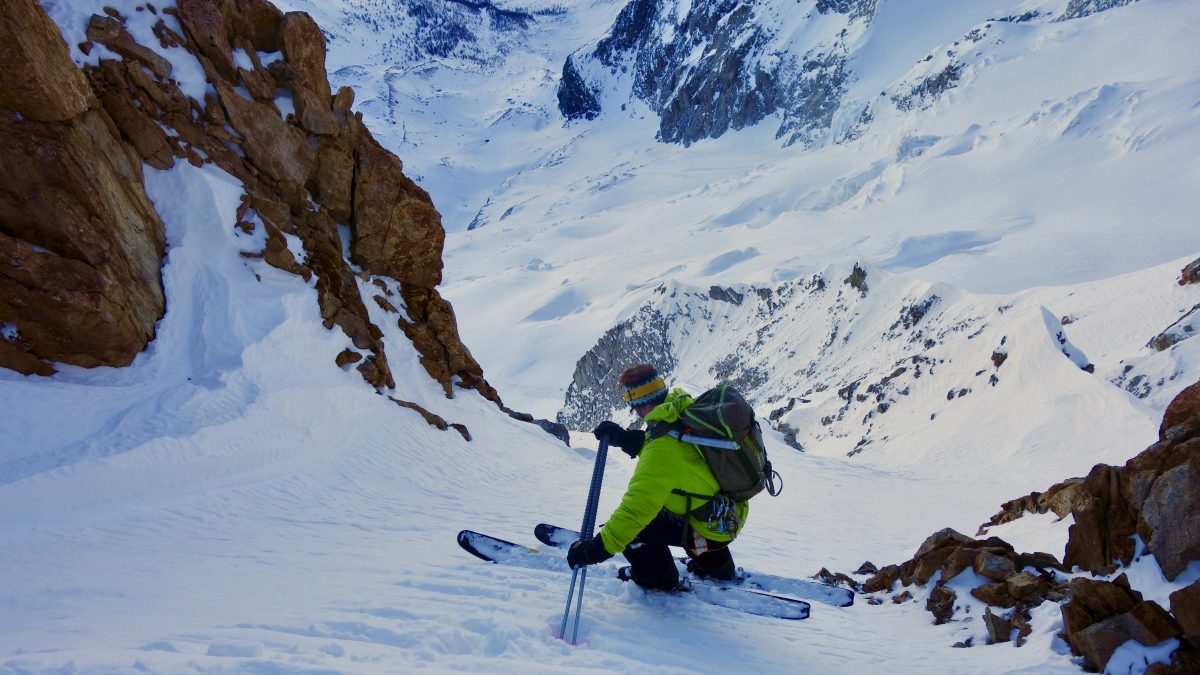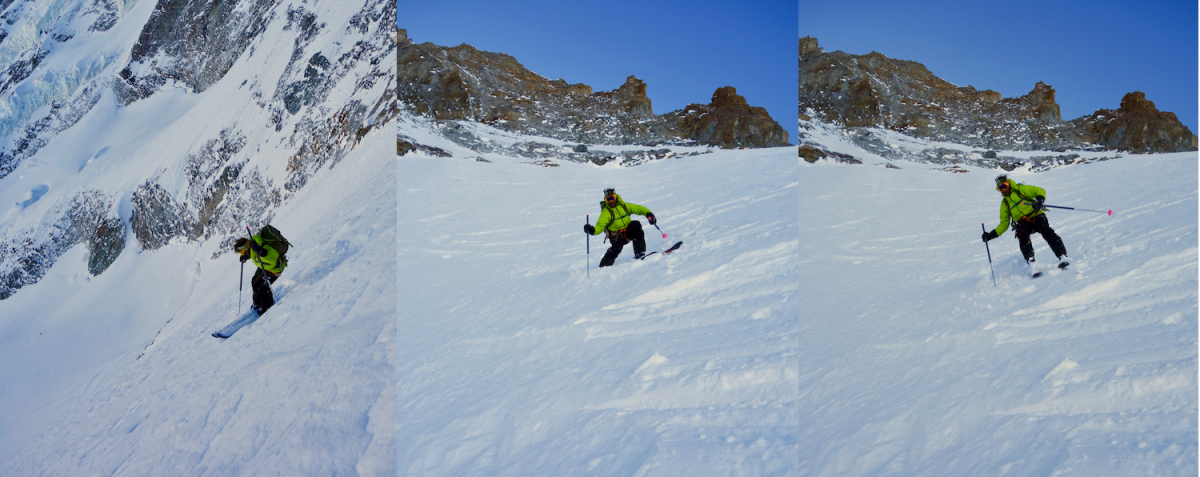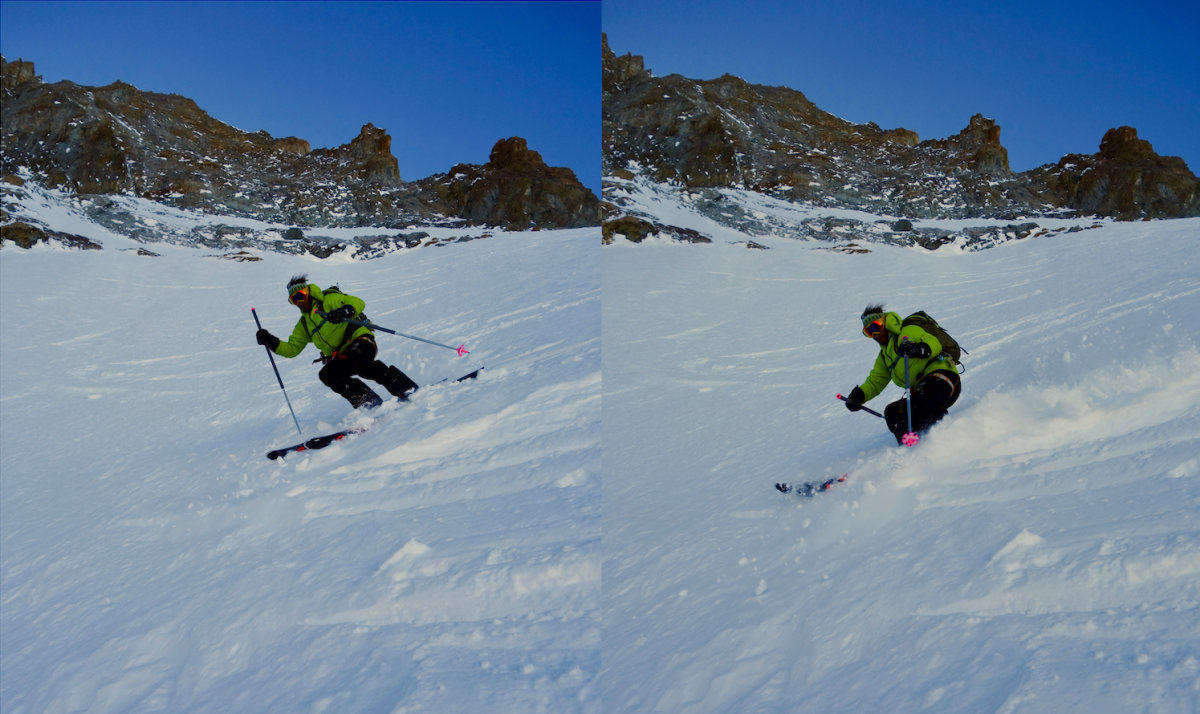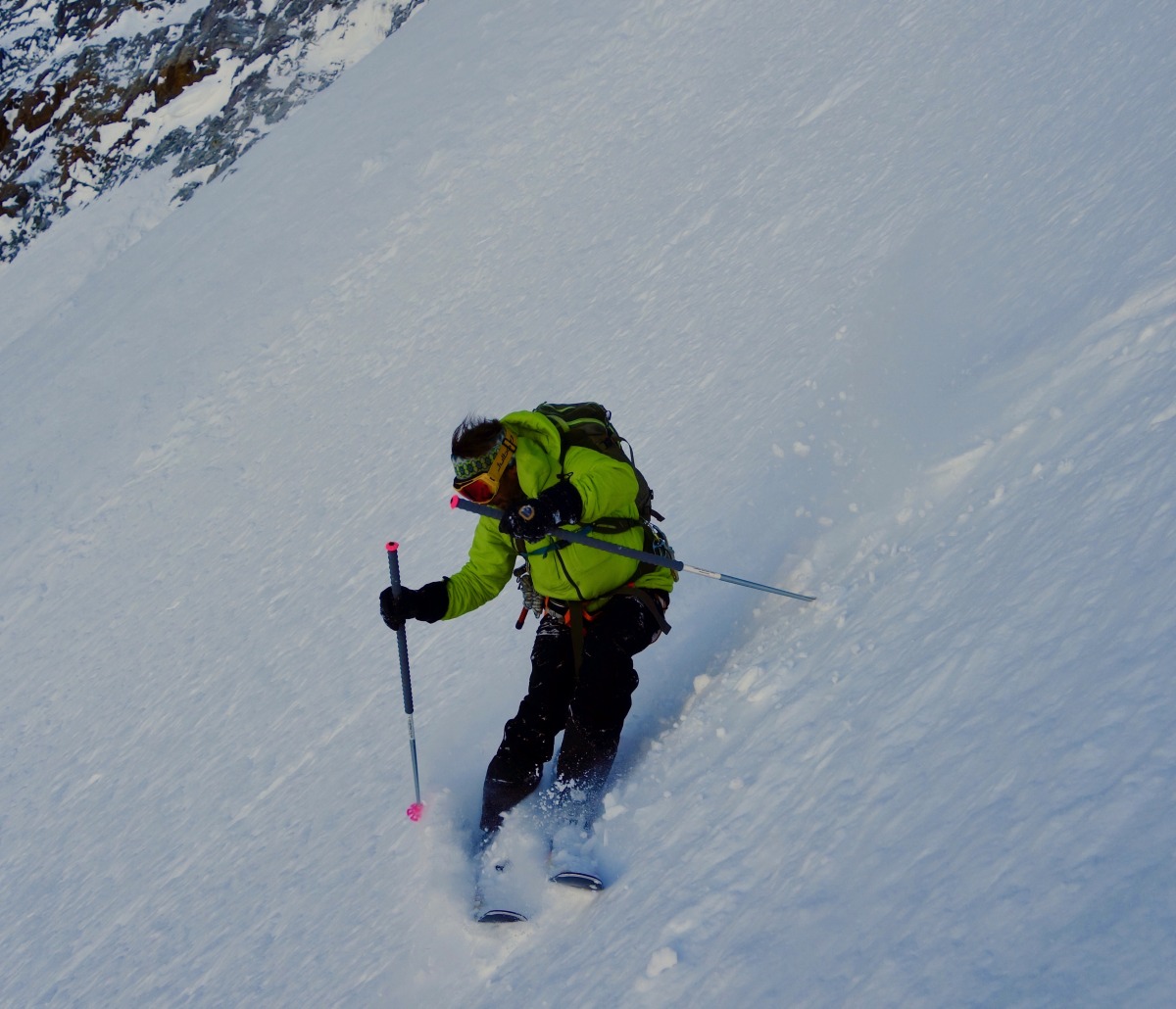
Adapted from piolet ramasse, applying the same technique with one’s poles allows a skier to stay upright and balanced. It should not be an invitation to lean back, or uphill, into the slope. Rather, it allows a skier to stay upright and over the skis, which to the less experienced will feel as if they’re leaning into the void. Here, Vallone negotiates a short, 50-plus section above the “Y-Grec” couloir. A fall here would be fatal. With soft conditions, he’s merely demo’ing the technique. Were it firm, he might have his piolet out for additional security. You can see it stashed here under his pack’s shoulder strap.
In the final excerpt from The Ski Guide Manual, Rob Coppolillo is joined by steep skiing guru Joe Vallone for an in depth tutorial on the art and form of steep skiing. Like what you’re reading? Support the cause and purchase your copy of the book.
Joe Vallone comes from a background in freestyle in the ’80s. After cutting his teeth in the “Aspen Extreme” days, he pursued mountain guiding and earned the highest certification possible, his IFMGA “pin.” He now lives in La Grave and guides steep terrain as much as anybody I know.
I had Joe Vallone’s attention during the off-season, so I capitalized on it. Huge thanks to him for sharing his approach. This is, again, one method for approaching steep skiing and working in steep terrain. It’s undoubtedly biased toward American, French, and Canadian techniques. Steal what you like, practice in non-consequential terrain, and ease into the real thing.
Modern steep skiing
If you haven’t watched films of the steep-skiing pioneers, give yourself an early holiday present and search online for “Anselme Baud,” “Sylvain Saudan,” or “Patrick Vallençant.” Saudan, the “skieur de l’impossible,” is considered one, if not the, ancestor of steep skiing. Riding 205-centimeter skis with leather boots in the late ’60s, at first local guides in Chamonix wouldn’t believe the slopes he’d ridden. Over time, though, he pioneered the art and madness of skiing extremely steep terrain. Watch video of him skiing routes that even today merit a “Wow” from the locals.
Nowadays, even entry-level gear offers superior performance to what Monsieur Saudan and his contemporaries used. Modern equipment and techniques have changed the game, but it’s no less consequential. We need to develop near-perfect technique, whether we’re sliding into the Gervasutti Couloir on Mont Blanc du Tacul or eyeing the north face of Buckner in the Cascades. So watch the masters of yesteryear work, but let’s try to update some of their techniques.
The position
As you ease into steeper and steeper terrain, you’ll want to commit to some basic techniques and tactics. First, do not find yourself leaning into the slope. You need to be balanced in the center of your skis, out over your feet and bindings. On the steepest slopes, this will feel as if you are leaning into the abyss. If you find yourself unable to commit to this position, you simply aren’t ready for that steep a slope. No shame — we’ve all been there, most of all me!
With that balanced position, now we need to keep our shoulders mostly squared to the fall line so that they are generally facing downhill, with your skis across the slope, perpendicular to the fall line. You’ll see and probably already know this requires fantastic upper and lower body separation. If you aren’t familiar with this term, then pursue some coaching, watch some videos, practice on piste, and get it done.
Having your shoulders facing (mostly) downhill, with your skis across the slope, sets you up to reach downslope for your next pole plant and provides dynamic tension between your trunk and legs. You’ll use this tension to initiate and execute a fast, fluid, powerful turn.
The turn
While watching the heroics of our steep-ski ancestors, you’ll see them performing wild turns on 200-centimeter-long skis, perched on slopes many would be psyched to climb with ice tools. Indeed, reading Saudan’s descriptions of his early techniques gives us a glimpse of how different these brave riders approached steep terrain. He describes adapting his alpine technique by leaning back to load the tails of his skis then whipping them around like a windshield wiper. In leather boots. Whoa!
Eventually steep skiers like Patrick Vallençant and Anselme Baud evolved the technique, modernizing it to something more familiar to us. For a modern turn, we want to maintain our balanced, centered position, staying in the “sweet spot” of our skis. Remember too that our skis might be slightly shorter than our freeriding boards. Our sweet spot will be even smaller, so a balanced, controlled stance is critical.

CLICK TO ENLARGE
Left: Head facing downhill, shoulders square, downhill pole planted below and even with the heels, in a controlled position—he’s ready to initiate a turn.
Middle: Here Vallone is starting to release his edges; he’s planted his downhill pole and he’s ready to turn around that pole, letting it fold forward with his turn. Note that he is looking straight down the fall line and his uphill (left) arm stays forward. The angle here has eased from near 50 to merely high 40s — for him, relaxed terrain; for the rest of us, “real” skiing.
Right: Mid-turn, Vallone maintains contact between his shovels and the snow surface, and his shoulders stay square to the fall line. Compare his position against the skyline—he has scarcely moved across the slope. Rather, he descends slightly but generates no momentum across the fall line. This keeps him in control and tight, setting him up for another precise turn.

CLICK TO ENLARGE
Left: The skis pivot around his pole; his left arm drives forward to initiate the next pole plant while the right arm and pole fold forward. His eyes still focus down the fall line, and he’s slightly forward on his skis. This is safe, controlled skiing above an open bergschrund a couple hundred meters more to the runout.
Right: Completing the turn, Vallone is already reaching downhill with his left arm to pole-plant and initiate the next turn. His right (now uphill) arm folds forward and points down the fall line, forcing his shoulders to remain square and down the slope. Again, note that he has traveled downhill, but scarcely across the fall line.
We separate our upper and lower bodies too. We don’t let our pole planting disrupt the turning of our legs. Watch a slalom skier and how she mows down gates with her arms while her legs go edge to edge and turn. Indeed, if you couldn’t see her lower half, it would be difficult to imagine how dynamic her turns are, given how controlled her upper body is. We’re striving for that same separation as we get into turning.
Our modern turn leaves the shovels of our skis as much in contact with the snow surface as possible as they come around. Our upper body is quiet and we don’t travel across the slope, just down the fall line, setting our edges to control our speed after each turn. This puts us in position for the next turn.
We prep for the next turn by planting our downhill pole firmly, approximately in line with the heel of our downhill ski. Our uphill pole also plants firmly, but slightly forward of our uphill foot. We use the poles to push into the snow, helping us to unweight the skis and initiate the turn.
The skis now come around, the shovels maintaining light contact with the slope, our tails pivoting around us. We lift the uphill arm to reach forward and become the downhill arm. (More on this in a moment, but the arm that starts downhill stays planted, and as we pivot around it, the arm “folds” forward.)
The skis end the turn with solid, committed edge pressure to stop or control our downhill momentum. The upper body remains quiet through the turn, to keep our momentum directly downslope, in the fall line. Any flailing of our upper body threatens to complicate our balance. Channel your inner Mikaela Shiffrin and keep your torso, shoulders, and arms quiet!
If we can link these turns fluidly, we’re sending. On the steepest terrain, you might make a single turn and come to a complete stop, controlling your downhill momentum.
The Coombs “Folding Pole”

Finishing a turn, Vallone’s uphill (left) arm is folding the pole forward, while his right arm is already forward and reaching for the next pole plant. His lower body has turned his skis perpendicular to the fall line, controlling his speed. On a slope like this, with good skipen for positive turns, Vallone would normally begin linking longer, “GS” turns, but I asked nicely and he demo’d some Coombs folding pole for us.
Now we’ll address the subtlety of the pole plant. In alpine skiing, the pole plant often derails the new skier’s turn. You see this from the chairlift, a newer skier over-rotating his shoulders and exaggerating the pole plant from side to side. This is why expert ski instructors sometimes give skiers “drills” to do without the poles, which in turn helps them perfect their lower body movements before integrating them with their upper body/pole plants.
Steep skiing has its own particular technique, the “folding pole plant.”
“Invented by the one and only Doug Coombs,” explains Vallone. “You turn around your downhill pole, not across the fall line. This is not a jump turn. The downhill/planted pole folds forward to allow us to come around. The new downhill arm is already reaching or it’s ready to reach for the next turn.”
“The steeper it gets, the more people lean back to ‘sit’ on the snow,” cautions Vallone. “Minimize the jump and keep your shovels in contact with the snow. You don’t want to go too far down the fall line.”
Another aspect of the folding pole (discovered, to me, as Vallone coached me to improve it!) is that it forces you to keep your hand pointing downhill. As you turn around the pole and fold it, you must keep your now-uphill shoulder square to the fall line and your hand pointing downhill, which keeps you in a controlled, balanced, and aggressive position.
You can find video of Coombs skiing online. Search and watch his technique, paying particular attention to the upper-lower body separation as well as the folding pole.
The Pedal-hop turn
Remember our definition of steep here is 45-plus degrees. Most instructional videos and steep-ski lessons tackle terrain well under 40 degrees. Well worth practicing but keep in mind mind that “real” terrain requires different techniques.
Modern ski-mountaineers have evolved past the jump turns of the 1970s, refining the technique to a dynamic unweighting of the skis, pivoting around the folding pole, and controlling their descent. A very, very select few, like Jérémie Heitz, Vivian Bruchez, Sam Anthamatten, and others, can link traditional alpine turns on 50-plus-degree terrain, but I’d caution against attempting that until . . . well, you’ll know when to get after it.
For us mere mortals, we can rely on the pedal-hop turn. Grainy footage going back to Valleçant’s days illustrate this technique. Reserved for extremely steep terrain, it’s a means to control our downhill momentum and get our skis around as quickly as possible.
1. We start the turn in our balanced, controlled stance, weight on the downhill ski, shoulders mostly down the fall line, downhill pole planted firmly by our downhill ski’s heelpiece, uphill pole closer to our uphill ski’s toepiece.
2. Before we initiate our turn, we transfer weight from our downhill ski to our uphill ski. Do this by loading the uphill ski edge and ever so slightly straightening the leg. As we do this, it releases our downhill ski. We lift this ski and begin to turn it, maintaining light contact with the tip as it pivots.
3. As the unweighted downhill leg begins the turn, we’re simultaneously loading our poles. Our poles take a bit of our weight, and our uphill leg straightens a bit to take the rest of our weight. We energetically and swiftly lift our uphill ski
and let it follow the downhill leg to pivot around our downhill pole.
4. The uphill leg pivots around to become our downhill leg. Our planted pole begins to fold downhill, down the fall line, allowing us to pivot around it and lose altitude. We land on our downhill leg with commitment and control. As we do this, our new downhill pole reaches for the next turn.
5. We should, in general, be able to see both our hands, at least in our peripheral vision. This keeps us driving forward into the next turn, and helps maintain an athletic stance with upper-lower body separation as well as a quiet upper body.
6. We land in control, in the fall line, while minimizing momentum across the slope. Our downhill pole is planted and ready. Next turn!
Rob Coppolillo is a mountain guide and writer, based on Vashon Island, in Puget Sound. He’s the author of The Ski Guide Manual.
